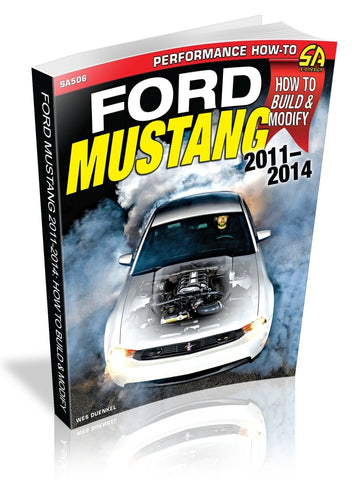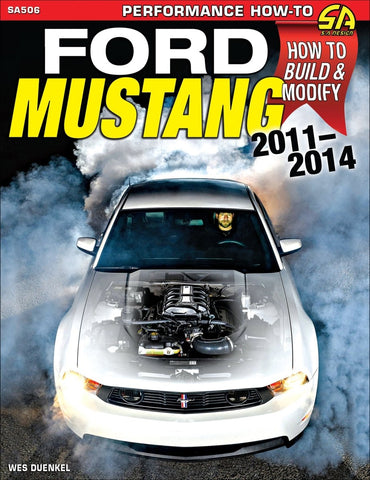Maximize the potential of your 2011–2014 Mustang with this book!
The Ford Mustang has seen quite an evolution in its 50-plus years of existence. Times change, consumer demands change, and sometimes, you stop and wonder, "How did we get here?" Ford’s designers and its customers were thinking the same thing in the early 2000s. The evolution from the classic original design to the New Edge styling of the 1999–2004 models had some scratching their heads. Ford decided to take a bold turn back to the Mustang’s roots with the fifth-generation model, which made its debut for the 2005 model year and lasted through 2014. Echoing the Mustang fastback design of the 1960s, Ford inspired a path of retro design that the Camaro and Challenger followed shortly thereafter. The move proved incredibly popular with enthusiasts. Of course, with car enthusiasts, the immediate thought was, "How can we make this new Mustang even better?"
The big news in 2011 was the introduction of the new 5.0-liter Coyote engine, which was a huge upgrade over the previous 4.6-liter engine. In Ford Mustang 2011–2014: How to Build and Modify, Mustang expert Wes Duenkel takes you through the entire car, system by system, to explore ways to get more performance out the last of the fifth-generation Mustangs. Included are chapters on engine modifications, brake and exhaust upgrades, power adders, chassis and suspension upgrades, cooling system modifications, and EFI and tuning tips. Wheels and tires, differentials, electronic upgrades, and more are also covered.
The 2011–2014 Mustangs are finding their way into the affordable category at present with warranties expiring and acquisition costs being very reasonable. Of course, as with all generations of Mustang, there is a robust aftermarket to explore for performance parts and accessories. Ford Mustang 2011–2014: How to Build and Modify covers it all and will help you make your Mustang everything you want it to be.
Acknowledgments
About the Author
Preface
Chapter 1: An Overview
America’s Blue-Collar Performance Car
Bucking the Trend
Fifth-Generation Mustang: The S197 Platform
Coyote Engine: From Pipe Dream to Production
Buying and Modifying an S197 Coyote
Chapter 2: Wheels and Tires
Wheels
Tires
Maximum Tire Performance at the Track
How-To Project: Wheel and Tire Upgrade
Chapter 3: Chassis and Suspension
Chassis
Suspension
How-To Project: Coilover Spring and Shock Package
Rear Suspension Geometry Upgrad
Chapter 4: Brakes
Brake Pads
Brake Calipers
Brake Discs
Brake Fluid
Brake Hoses
Cooling
How-To Project: Complete Brake Upgrade
Chapter 5: Drivetrain
Clutches
Shifters
Manual Transmissions
Automatic Transmissions
Rear Axle Upgrades
How-To Project: Clutch and Manual Transmission Upgrade
Chapter 6: Bolt-On Power Upgrades
Air Intake Systems
Throttle Bodies
Intake Manifolds
Headers
Mid-Pipes
Axle-Back Exhaust
Handheld Tuners
How-To Project: Long-Tube Headers and Exhaust System Installation
Chapter 7: Coyote Care and Feeding
Lubrication
Cooling
How-To Project: Cooling Upgrade
Chapter 8: Power Adders
Nitrous Oxide
Supercharging
Turbocharging
How-To Project: Supercharger System Installation
Chapter 9: PCM Tuning
Innovations
Electronic Throttle Control and Aftermarket Throttle Bodies
Ti-VCT and Aftermarket Camshafts
Wideband Oxygen Sensors and Tuning
MAF Sensor and Changing Intake Tubes
Mechanical Returnless Fuel System and Increasing Fuel Supply
Knock Sensors and Spark Tuning
Tuning Tools and Methods
How-To Project: MAF Sensor Calibration
Epilogue
Source Guide
Maximize the potential of your 2011–2014 Mustang with this book!
The Ford Mustang has seen quite an evolution in its 50-plus years of existence. Times change, consumer demands change, and sometimes, you stop and wonder, "How did we get here?" Ford’s designers and its customers were thinking the same thing in the early 2000s. The evolution from the classic original design to the New Edge styling of the 1999–2004 models had some scratching their heads. Ford decided to take a bold turn back to the Mustang’s roots with the fifth-generation model, which made its debut for the 2005 model year and lasted through 2014. Echoing the Mustang fastback design of the 1960s, Ford inspired a path of retro design that the Camaro and Challenger followed shortly thereafter. The move proved incredibly popular with enthusiasts. Of course, with car enthusiasts, the immediate thought was, "How can we make this new Mustang even better?"
The big news in 2011 was the introduction of the new 5.0-liter Coyote engine, which was a huge upgrade over the previous 4.6-liter engine. In Ford Mustang 2011–2014: How to Build and Modify, Mustang expert Wes Duenkel takes you through the entire car, system by system, to explore ways to get more performance out the last of the fifth-generation Mustangs. Included are chapters on engine modifications, brake and exhaust upgrades, power adders, chassis and suspension upgrades, cooling system modifications, and EFI and tuning tips. Wheels and tires, differentials, electronic upgrades, and more are also covered.
The 2011–2014 Mustangs are finding their way into the affordable category at present with warranties expiring and acquisition costs being very reasonable. Of course, as with all generations of Mustang, there is a robust aftermarket to explore for performance parts and accessories. Ford Mustang 2011–2014: How to Build and Modify covers it all and will help you make your Mustang everything you want it to be.
Acknowledgments
About the Author
Preface
Chapter 1: An Overview
America’s Blue-Collar Performance Car
Bucking the Trend
Fifth-Generation Mustang: The S197 Platform
Coyote Engine: From Pipe Dream to Production
Buying and Modifying an S197 Coyote
Chapter 2: Wheels and Tires
Wheels
Tires
Maximum Tire Performance at the Track
How-To Project: Wheel and Tire Upgrade
Chapter 3: Chassis and Suspension
Chassis
Suspension
How-To Project: Coilover Spring and Shock Package
Rear Suspension Geometry Upgrad
Chapter 4: Brakes
Brake Pads
Brake Calipers
Brake Discs
Brake Fluid
Brake Hoses
Cooling
How-To Project: Complete Brake Upgrade
Chapter 5: Drivetrain
Clutches
Shifters
Manual Transmissions
Automatic Transmissions
Rear Axle Upgrades
How-To Project: Clutch and Manual Transmission Upgrade
Chapter 6: Bolt-On Power Upgrades
Air Intake Systems
Throttle Bodies
Intake Manifolds
Headers
Mid-Pipes
Axle-Back Exhaust
Handheld Tuners
How-To Project: Long-Tube Headers and Exhaust System Installation
Chapter 7: Coyote Care and Feeding
Lubrication
Cooling
How-To Project: Cooling Upgrade
Chapter 8: Power Adders
Nitrous Oxide
Supercharging
Turbocharging
How-To Project: Supercharger System Installation
Chapter 9: PCM Tuning
Innovations
Electronic Throttle Control and Aftermarket Throttle Bodies
Ti-VCT and Aftermarket Camshafts
Wideband Oxygen Sensors and Tuning
MAF Sensor and Changing Intake Tubes
Mechanical Returnless Fuel System and Increasing Fuel Supply
Knock Sensors and Spark Tuning
Tuning Tools and Methods
How-To Project: MAF Sensor Calibration
Epilogue
Source Guide










